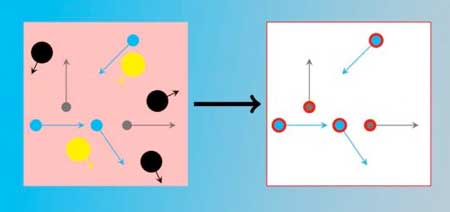| Nov 13, 2018 |
New finding of particle physics may help to explain the absence of antimatter
|
|
(Nanowerk News) In the Standard Model of particle physics, there is almost no difference between matter and antimatter. But there is an abundance of evidence that our observable universe is made up only of matter - if there was any antimatter, it would annihilate with nearby matter to produce very high intensity gamma radiation, which has not been observed. Therefore, figuring out how we ended up with an abundance of only matter is one of the biggest open questions in particle physics.
|
|
Because of this and other gaps in the Standard Model, physicists are considering theories which add a few extra particles in ways that will help to solve the problem. One of these models is called the Two Higgs Doublet Model, which, despite the name, actually adds four extra particles. This model can be made to agree with all particle physics observations made so far, including ones from the Large Hadron Collider at CERN, but it was unclear whether it could also solve the problem of the matter-antimatter imbalance. The research group, led by a University of Helsinki team, set out to tackle the problem from a different angle.
|
|
Their findings have now been published in a paper in the Physical Review Letters ("Nonperturbative Analysis of the Electroweak Phase Transition in the Two Higgs Doublet Model").
|
 |
| Sketch of dimensional reduction. (Image: David Weir)
|
|
About ten picoseconds after the Big Bang - right about the time the Higgs boson was turning on - the universe was a hot plasma of particles.
|
|
"The technique of dimensional reduction lets us replace the theory which describes this hot plasma with a simpler quantum theory with a set of rules that all the particles must follow", explains Dr. David Weir, the corresponding author of the article.
|
|
"It turns out that the heavier, slower-moving particles don't matter very much when these new rules are imposed, so we end up with a much less complicated theory."
|
|
This theory can then be studied with computer simulations, which provide a clear picture of what happened. In particular, they can tell us how violently out of equilibrium the universe was when the Higgs boson turned on. This is important for determining whether there was scope for producing the matter-antimatter asymmetry at this time in the history of the universe using the Two Higgs Doublet Model.
|
|
"Our results showed that it is indeed possible to explain the absence of antimatter and remain in agreement with existing observations", Dr. Weir remarks. Importantly, by making use of dimensional reduction, the new approach was completely independent of any previous work in this model.
|
|
If the Higgs boson turned on in such a violent way, it would have left echoes. As the bubbles of the new phase of the universe nucleated, much like clouds, and expanded until the universe was like an overcast sky, the collisions between the bubbles would have produced lots of gravitational waves. Researchers at the University of Helsinki and elsewhere are now gearing up to look for these gravitational waves at missions such as the European LISA project.
|

